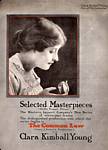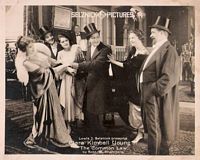

The Common Law (1916) Clara Kimball Young Film Corp. Distributor: Lewis J. Selznick Enterprises, Inc; Selznick Pictures. Director: Albert Capellani. Assistant Director: Henri Menessier. Scenario: Beryl Morhange. Camera: Jacques Monteran and Hal Young. Cast: Clara Kimball Young, Conway Tearle, Paul Capellani, Edna Hunter, Lillian Cook, Julia Stuart, Edward M. Kimball, Lydia Knott, D.J. Flanagan. 7 reels. This film is apparently LOST
This was the first film produced by the Clara Kimball Young Film Corp., the company Young and Selznick set up after he was ousted from World. At 7 reels, it was the longest film she had yet made. It was remade in 1923 with Corinne Griffith and in 1931 with Constance Bennett.
| Click image to view the British "Press Book." Includes detailed synopsis, musical cue sheet, pictures, and advertising |
 |
 |
Still from the film Click thumbnail for larger image. Thanks to Derek Boothroyd for this scan. |
| Valerie West | Clara Kimball Young |
| Neville | Conway Tearle |
| Querida | Paul Capellani |
| Rita | Edna Hunter |
| Stephanie | Lillan Cook |
| Mrs. Neville | Julia Stewart |
| Mr. Neville | Edward M. Kimball |
| Mrs. West | Lydia Knott |
| Ogilvy | D.J. Flanagan |
Lewis J. Selznick has released the first of the Clara Kimball Young pictures, a seven reeler entitled "The Common Law," from the book of the same title by Robert W. Chambers, directed by Albert Capellani. From an artistic standpoint the picture is very well done, following the story of the book so closely that it contains all the weakness of the original novel as well as all the strong punches, and to Mr. Capellani must be given credit for having achieved an exceedingly artistic production from the scenic, lighting and acting standpoint. A splendid cast was assembled to support the acting of Miss Young, who played the stellar role with distinction. But the picture in itself is too long from the exhibitors' standpoint. It ran just a little longer than an hour and three-quarters at the private showing which was given at the St. Regis Hotel last week. But for that matter nearly all seven-reel pictures are too long for the big business possibilities of the usual exhibitor, and in the case of "The Common Law there are several scenes that could be cut out entirely, not only as an aid to the picture itself, but as a help to the story. It would be a simple matter to cut at least a thousand feet from the picture, and this would speed up the action, which at times is draggy and help the picture from the exhibitor's standpoint by shortening the running time. At the very start of the picture there is entirely too much cutting back and forth in the scenes leading up to the real action of the pictures's plot. Valerie West (Clara Kimball Young) is a girl of refinement and education who left practically destitute through the death of her mother, is forced into accepting a position as a model. The most thrilling scenes are those in the studio of Neville, where Valerie is posing "in the nude." Here the director has done his best work. He has worked out an idea of showing but part of the form of the woman and leaving those who view the picture to use their imagination as to the rest. They are scenes that could have easily been overdone and made salacious and suggestive in the hands of an overzealous producer, but Mr. Capellani has given just the required touch. At this time Valerie is in demand and Querida (Paul Capellani), a Spanish artist, becomes infatuated with her. His law in regard to women is "the common law;" no marriage for him. His life is "just one woman after another." However at this point Stephanie (Lillian Cook), Neville's adopted sister, who is in love with him and who, it is generally conceded by relatives and friends, is to wed him enters the picture. She has been neglected by Neville, who has fallen in love with his model. She pleads with Valerie to leave him before he ruins his career, and Valerie promises that she will never marry him. Then to crush down her emotion she joins Querida at a New Year's Eve party. (Here is where a slight doubt enters the mind as to how a girl who has been naught but a model and who a short time before was poverty stricken, managed to gather so many wonderful clothes in so short a time by simply posing.) Neville sees her at the party and takes her from it to his studio, proposes to her and is put off, after being refused, by Valerie promising to give herself to him on the first of June without the formality of a ceremony. In the intervening months the tangled threads of the plot are straightened out and after Valerie manages to kill Querida by throwing him out of the window of her apartment when he attacks her, the Neville family give their consent to the marriage of the son and his mode. As a money-getter "The Common Law" will prove a box-office attraction of the first rank, but it is a picture that one will have to play for more than a day in order to get the benefit of the cumulative advertising value.
"The Common Law"
Clara Kimball Young Irresistible in Seven-Reel Adaptation of Robert W. Chambers' Novel Presented by Lewis J. Selznick.
Reviewed by Ben H. Grimm.
"The Common Law," a seven-reel picturization of the novel by Robert W. Chambers presented by Lewis J. Selznick and Clara Kimball Young Film Corporation, is truly a remarkable production. The appeal of Clara Kimball Young in this picture is irresistible, and she is surrounded by an excellent cast. If the characters in Mr. Chambers's novel had walked out of the pages of his book they could scarcely have been more true to type than they appear in this picture. The seven reels are a quite faithful visualization of the sociological plot, with the exception that several of the more objectionable--or what could have been made more objectionable--situations are noticeable by their propriety.
Continuity throughout the picture could hardly be improved upon, and the story is smoothly narrated on the screen with the use of fewer subtitles than many productions of shorter length. the subtitles, too, are made artistically attractive by the use of decorative designs. Director-General Albert Capellani has lent artistic touches to the whole that add to the production's worth. Many of the settings, particularly in the studio scenes, are magnificent.
Throughout the development of the character of a young girl of education and refinement who is forced to seek employment as an artists' model, Clara Kimball Young draws the spectator into a state of sympathetic solicitude for her. The story abounds with dramatic situations which are interpreted to their fullest possibilities by Miss Young, a Valerie West, artist's model, and Conway Tearle as Louis Neville, the artist. A situation in which Miss Young is called upon to reach the highest degree of her ability occurs when Valerie, pure in heart, sets a day upon which she tells Neville she will come to him as his common law wife. In this scene Miss Young is supreme. She compels the sympathy of the spectator, especially so when the spectator has followed her through the previous action in which the adopted daughter of Neville's parents, who is also in love with the artist, has extracted Valerie's promise not to marry Neville because it would ruin his career if he were to marry his model. In fact the role of Valerie is a difficult one, which has been handled by Miss Young in a manner that proves she is an emotional actress of high calibre.
The heavy role in the production--Querida--has been ably and forcefully portrayed by Paul Capellani, and a personality that charms is that of Lillian Cook, who plays the adopted daughter of the Nevilles. Edna Hunter plays the rather sympathetic part of Rita. Others in the cast are Julia Stuart, Edward Kimball, Lydia Knott, D.J. Flannigan, and Edmund Mortimer.
On the whole, "The Common Law" will prove a box office magnet.
Last revised October 2, 2010